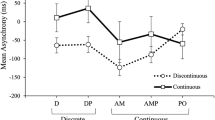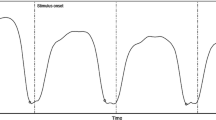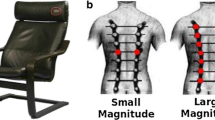Abstract
Sensorimotor synchronization is hypothesized to arise through two different processes, associated with continuous or discontinuous rhythmic movements. This study investigated synchronization of continuous and discontinuous movements to different pacing signals (auditory or visual), pacing interval (500, 650, 800, 950 ms) and across effectors (non-dominant vs. non-dominant hand). The results showed that mean and variability of asynchronization errors were consistently smaller for discontinuous movements compared to continuous movements. Furthermore, both movement types were timed more accurately with auditory pacing compared to visual pacing and were more accurate with the dominant hand. Shortening the pacing interval also improved sensorimotor synchronization accuracy in both continuous and discontinuous movements. These results show the dependency of temporal control of movements on the nature of the motor task, the type and rate of extrinsic sensory information as well as the efficiency of the motor actuators for sensory integration.



Similar content being viewed by others
References
Aschersleben G (2002) Temporal control of movements in sensorimotor synchronization. Brain Cogn 48:66–79. doi:10.1006/brcg.2001.1304
Aschersleben G, Prinz W (1995) Synchronizing actions with events: the role of sensory information. Percept Psychophys 57:305–317
Barttlett NR, Bartlett SC (1959) Synchronization of a motor response with an anticipated sensory event. Psychol Rev 66:203–218
Breznitz Z, Meyler A (2003) Speed of lower-level auditory and visual processing as a basic factor in dyslexia: electrophysiological evidence. Brain Lang 85:166–184
Dunlap K (1910) Reaction to rhythmic stimuli with attempt to synchronize. Psychol Rev 17:399–416
Ivry RB, Spencer RM, Zelaznik HN, Diedrichsen J (2002) The cerebellum and event timing. Ann N Y Acad Sci 978:302–317
Jancke L, Specht K, Mirzazade S, Loose R, Himmelbach M, Lutz K, Shah NJ (1998) A parametric analysis of the ‘rate effect’ in the sensorimotor cortex: a functional magnetic resonance imaging analysis in human subjects. Neurosci Lett 252:37–40
Jancke L, Loose R, Lutz K, Specht K, Shah NJ (2000) Cortical activations during paced finger-tapping applying visual and auditory pacing stimuli. Brain Res Cogn Brain Res 10:51–66
Kay BA, Kelso JA, Saltzman EL, Schoner G (1987) Space-time behavior of single and bimanual rhythmical movements: data and limit cycle model. J Exp Psychol Hum Percept Perform 13:178–192
Koch G, Oliveri M, Caltagirone C (2009) Neural networks engaged in milliseconds and seconds time processing: evidence from transcranial magnetic stimulation and patients with cortical or subcortical dysfunction. Philos Trans R Soc Lond B Biol Sci 364:1907–1918. doi:10.1098/rstb.2009.0018
Krause V, Pollok B, Schnitzler A (2010) Perception in action: the impact of sensory information on sensorimotor synchronization in musicians and non-musicians. Acta Psychol (Amst) 133:28–37. doi:10.1016/j.actpsy.2009.08.003
Lewis PA, Miall RC (2009) The precision of temporal judgement: milliseconds, many minutes, and beyond. Philos Trans R Soc Lond B Biol Sci 364:1897–1905. doi:10.1098/rstb.2009.0020
Meck WH, Penney TB, Pouthas V (2008) Cortico-striatal representation of time in animals and humans. Curr Opin Neurobiol 18:145–152. doi:10.1016/j.conb.2008.08.002
Merchant H, Zarco W, Bartolo R, Prado L (2008) The context of temporal processing is represented in the multidimensional relationships between timing tasks. PLoS One 3:e3169. doi:10.1371/journal.pone.0003169
Oldfield RC (1971) The assessment and analysis of handedness: the Edinburgh inventory. Neuropsychologia 9:97–113
Patel AD, Iversen JR, Bregman MR, Schulz I (2009) Studying synchronization to a musical beat in nonhuman animals. Ann N Y Acad Sci 1169:459–469. doi:10.1111/j.1749-6632.2009.04581.x
Pollok B, Krause V, Butz M, Schnitzler A (2009) Modality specific functional interaction in sensorimotor synchronization. Hum Brain Mapp 30:1783–1790. doi:10.1002/hbm.20762
Repp BH (1999) Control of expressive and metronomic timing in pianists. J Mot Behav 31:145–164. doi:10.1080/00222899909600985
Repp BH (2003) Rate limits in sensorimotor synchronization with auditory and visual sequences: the synchronization threshold and the benefits and costs of interval subdivision. J Mot Behav 35:355–370. doi:10.1080/00222890309603156
Repp BH (2005) Sensorimotor synchronization: a review of the tapping literature. Psychon Bull Rev 12:969–992
Repp BH (2011) Comfortable synchronization of cyclic drawing movements with a metronome. Hum Mov Sci 30:18–39. doi:10.1016/j.humov.2010.09.002
Repp BH, Penel A (2002) Auditory dominance in temporal processing: new evidence from synchronization with simultaneous visual and auditory sequences. J Exp Psychol Hum Percept Perform 28:1085–1099
Robertson SD, Zelaznik HN, Lantero DA, Bojczyk KG, Spencer RM, Doffin JG, Schneidt T (1999) Correlations for timing consistency among tapping and drawing tasks: evidence against a single timing process for motor control. J Exp Psychol Hum Percept Perform 25:1316–1330
Rodger MW, Craig CM (2011) Timing movements to interval durations specified by discrete or continuous sounds. Exp Brain Res 214:393–402. doi:10.1007/s00221-011-2837-2
Schoner G (2002) Timing, clocks, and dynamical systems. Brain Cogn 48:31–51. doi:10.1006/brcg.2001.1302
Schulte-Korne G, Bruder J (2010) Clinical neurophysiology of visual and auditory processing in dyslexia: a review. Clin Neurophysiol 121:1794–1809. doi:10.1016/j.clinph.2010.04.028
Semjen A, Schulze HH, Vorberg D (2000) Timing precision in continuation and synchronization tapping. Psychol Res 63:137–147
Serrien DJ (2008) The neural dynamics of timed motor tasks: evidence from a synchronization-continuation paradigm. Eur J Neurosci 27:1553–1560. doi:10.1111/j.1460-9568.2008.06110.x
Spencer RM, Zelaznik HN, Diedrichsen J, Ivry RB (2003) Disrupted timing of discontinuous but not continuous movements by cerebellar lesions. Science 300:1437–1439. doi:10.1126/science.1083661
Stevens LT (1886) On the time-sense. Mind 11:393–404
Studenka BE, Zelaznik HN (2008) The influence of dominant versus non-dominant hand on event and emergent motor timing. Hum Mov Sci 27:29–52. doi:10.1016/j.humov.2007.08.004
Studenka BE, Zelaznik HN (2011) Circle drawing does not exhibit auditory-motor synchronization. J Mot Behav 43:185–191. doi:10.1080/00222895.2011.555796
Toplak ME, Dockstader C, Tannock R (2006) Temporal information processing in ADHD: findings to date and new methods. J Neurosci Methods 151:15–29. doi:10.1016/j.jneumeth.2005.09.018
Torre K, Balasubramaniam R (2009) Two different processes for sensorimotor synchronization in continuous and discontinuous rhythmic movements. Exp Brain Res 199:157–166. doi:10.1007/s00221-009-1991-2
Wiener M, Matell MS, Coslett HB (2011) Multiple mechanisms for temporal processing. Front Integr Neurosci 5:31. doi:10.3389/fnint.2011.00031
Wing AM (2002) Voluntary timing and brain function: an information processing approach. Brain Cogn 48:7–30. doi:10.1006/brcg.2001.1301
Wing AM, kristofferson AB (1973a) The timing of interresponse intervals. Percept Psychophys 13:455–460
Wing AM, kristofferson AB (1973b) Response delays and the timing of discrete motor responses. Percept Psychophys 14:5–12
Zelaznik HN, Rosenbaum DA (2010) Timing processes are correlated when tasks share a salient event. J Exp Psychol Hum Percept Perform 36:1565–1575. doi:10.1037/a0020380
Zelaznik HN, Spencer RM, Doffin JG (2000) Temporal precision in tapping and circle drawing movements at preferred rates is not correlated: further evidence against timing as a general-purpose ability. J Mot Behav 32:193–199. doi:10.1080/00222890009601370
Zelaznik HN, Spencer RM, Ivry RB (2002) Dissociation of explicit and implicit timing in repetitive tapping and drawing movements. J Exp Psychol Hum Percept Perform 28:575–588
Zelaznik HN, Spencer RM, Ivry RB et al (2005) Timing variability in circle drawing and tapping: probing the relationship between event and emergent timing. J Mot Behav 37:395–403. doi:10.3200/JMBR.37.5.395-403
Author information
Authors and Affiliations
Corresponding author
Rights and permissions
About this article
Cite this article
Lorås, H., Sigmundsson, H., Talcott, J.B. et al. Timing continuous or discontinuous movements across effectors specified by different pacing modalities and intervals. Exp Brain Res 220, 335–347 (2012). https://doi.org/10.1007/s00221-012-3142-4
Received:
Accepted:
Published:
Issue Date:
DOI: https://doi.org/10.1007/s00221-012-3142-4




